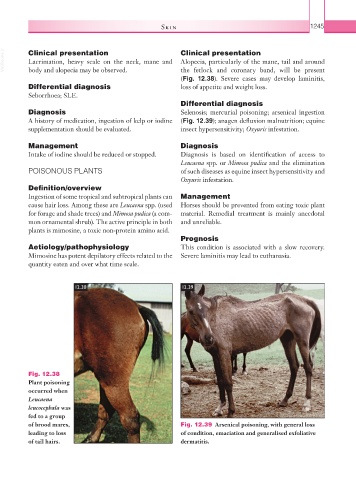Page 1270 - Equine Clinical Medicine, Surgery and Reproduction, 2nd Edition
P. 1270
Skin 1245
VetBooks.ir Clinical presentation Clinical presentation
Lacrimation, heavy scale on the neck, mane and
Alopecia, particularly of the mane, tail and around
the fetlock and coronary band, will be present
body and alopecia may be observed.
(Fig. 12.38). Severe cases may develop laminitis,
Differential diagnosis loss of appetite and weight loss.
Seborrhoea; SLE.
Differential diagnosis
Diagnosis Selenosis; mercurial poisoning; arsenical ingestion
A history of medication, ingestion of kelp or iodine (Fig. 12.39); anagen defluxion malnutrition; equine
supplementation should be evaluated. insect hypersensitivity; Oxyuris infestation.
Management Diagnosis
Intake of iodine should be reduced or stopped. Diagnosis is based on identification of access to
Leucaena spp. or Mimosa pudica and the elimination
POISONOUS PLANTS of such diseases as equine insect hypersensitivity and
Oxyuris infestation.
Definition/overview
Ingestion of some tropical and subtropical plants can Management
cause hair loss. Among these are Leucaena spp. (used Horses should be prevented from eating toxic plant
for forage and shade trees) and Mimosa pudica (a com- material. Remedial treatment is mainly anecdotal
mon ornamental shrub). The active principle in both and unreliable.
plants is mimosine, a toxic non-protein amino acid.
Prognosis
Aetiology/pathophysiology This condition is associated with a slow recovery.
Mimosine has potent depilatory effects related to the Severe laminitis may lead to euthanasia.
quantity eaten and over what time scale.
12.38 12.39
Fig. 12.38
Plant poisoning
occurred when
Leucaena
leucocephala was
fed to a group
of brood mares, Fig. 12.39 Arsenical poisoning, with general loss
leading to loss of condition, emaciation and generalised exfoliative
of tail hairs. dermatitis.

